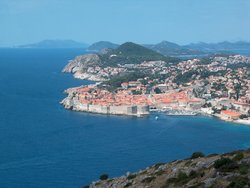Dubrovnik
|
|
Dubrovnik_in_croatia.jpg
Position of Dubrovnik within Croatia
Dubrovnik (Latin Ragusa), population 43,770 in 2001, 49,728 in 1991 is a port and one of the most prominent tourist resorts on the Adriatic Sea coast in the extreme south of Croatia, and the center of the Dubrovnik-Neretva county, positioned at 42.39N Lat and 18.04E Long. It has the nickname "Pearl of the Adriatic".
The city of Ragusa/Dubrovnik was based on maritime trade, and in the Middle Ages it became the only eastern Adriatic city-state to rival Venice. Supported by its wealth and skilled diplomacy, the Latin/Slavic Ragusa/Dubrovnik achieved a remarkable level of development during the 15th and 16th century. Dubrovnik was one of the centers of the development of the Croatian language and literature, home to many notable poets, playwrights, painters, mathematicians, physicists and other scholars.
History
See also Republic of Dubrovnik.
Dubrovnik was founded by joining two small towns: Laus (name comes from the Latin word for rock) which was on a small island off the southern Dalmatian coast, providing shelter for the Italic refugees from the nearby city of Epidaurum (today Cavtat); and Dubrava (named after the Slavic word dub for oak), a settlement of the Slavic immigrants at the foothill of the forested Srđ hill.
The strip of wetland, built in 1667 after an earthquake destroyed most of the city, was later reclaimed as a landfill, unifying the city around the newly made plaza (today Placa or Stradun). The city was fortified and two harbors were built on each side of the isthmus.
From its establishment in the 7th century AD, the town was under the protection of the Byzantine Empire. After the Crusades, Ragusa/Dubrovnik came under the sovereignty of Venice (1205–1358), and by the Peace Treaty of Zadar in 1358 it became part of the Hungarian-Croatian Kingdom.
Dubrovnik.jpg
Between 14th century and 1808 Dubrovnik ruled itself as a free state named Respublica Ragusina (Ragusan republic), also known as Republic of Dubrovnik. The Ragusan Republic reached its peak in the 15th and 16th centuries, when the Dubrovnik thalassocracy rivalled the Venetian Republic and other Italian maritime republics.
The city was ruled by aristocracy that formed two city Councils (Vijeće). They maintained a strict system of social classes, but they also abolished slave trade early in the 15th century and highly valued liberty. The city successfully balanced its sovereignty between the interests of Venice and the Ottoman Empire for centuries.
The Republic gradually declined after a crisis of Mediterranean shipping and especially a catastrophic earthquake of 1667. In 1699 it was forced to sell two patches of its territory to the Ottomans in order to protect itself from the advancing Venetian forces.
Its final demise was caused not by Venice, but by Napoleon's forces which conquered first the Venetian territories and then the Dubrovnik Republic in 1806. In 1808 Marshal Marmont abolished the Dubrovnik Republic and amalgamated its territory into the Illyrian provinces.
In 1815, by the resolution of Congress of Vienna, Dubrovnik was annexed to Austria (later Austria-Hungary), and remained annexed until 1918, when it became part of the Kingdom of Serbs, Croats and Slovenes (Yugoslavia from 1929). At the very beginning of the World War II, Dubrovnik was first part of the Independent State of Croatia. From April 1941 until September 1943 Dubrovnik was occupied by the Italian army and after that by the Germans. In October 1944 the Partisans liberated Dubrovnik from the Germans and it became part of the second Yugoslavia in 1945.
Dubrovnik-L04-1.jpg
Despite the 1970s demilitarization of the old town by the Yugoslav People's Army in an attempt to prevent it from becoming a casualty of war, following Croatia's independence in 1991, the same army bombarded the old city on December 6, 1991, causing some damage. The rest of the city was less fortunate in the siege that lasted from October 1991 until May 1992. Casualty estimates in the conflict on this area vary. Some Serbian sources put it at 88 on both sides, while the Croatian Red Cross counted 114 killed civilians.
Following the end of the war, a major rebuilding project led by the Croatian authorities and UNESCO began. They rebuilt the city in the ancient style, so as to keep its sense of beauty and history. As well as rebuilding damaged buildings, surviving structures were strengthened against earthquakes. As of 2005, most damaged buildings in the city have been repaired.
Miscellaneous
The patron saint of the city is Sveti Vlaho, whose statues are seen around the city. It has a importance similar to that of St. Mark Evangelist to Venice. The old city is a World Heritage Site.
Inhabitants of Dubrovnik often proudly quote the Irish playwright and man of letters, George Bernard Shaw, who visited the city in 1929: "If you want to see heaven on earth, come to Dubrovnik".
Dubrovnik hosted the tenth and final Congrès Internationaux d'Architecture Moderne in 1956.
The oldest arboretum in the world, Arboretum Trsteno, dating from before 1492, is near Dubrovnik.
The Republic of Dubrovnik was the first state to recognise the United States of America as a sovereign state.
External links
- Dubrovnik Online, travel guide for Dubrovnik and the surrounding region (http://www.dubrovnik-online.com/)
- Chronology of Dubrovnik (http://free-du.htnet.hr/dubrovniktaxi/Chronology%20of%20Dubrovnik.htm)
- Dubrovnik - in English (http://about.dubrovnikbedandbreakfast.com/index.htm)
- Official web pages of the city (http://www.dubrovnik.hr/)
- Information and Guide about Dubrovnik (http://www.dubrovnik-guide.net/)
- Dubrovnik Summer Festival (http://www.dubrovnik-festival.hr/default.asp?ru=2)
- Dubrovnik, Konavle, Boka kotorska (http://www.hr/darko/etf/et111.html)
- Special Report Dubrovnik after war Recovery and remembrance (http://www.natcath.com/NCR_Online/archives/110201/110201g.htm)
- Dubrovnik e-zine (http://www.dubrovnikportal.com/)
- Dubrovnik apartments - search rental private accommodation (http://www.dubrovnikapartments.net/)
The English word Argosy is derived from ragusye which means vessel of Ragusa (old name of Dubrovnik).
The music group The Dubrovniks owes its name to the origin of the father of one of the members.da:Dubrovnik de:Dubrovnik es:Dubrovnik fr:Dubrovnik hr:Dubrovnik it:Ragusa (Croazia) nl:Dubrovnik ja:ドゥブロヴニク pl:Dubrownik ro:Dubrovnik ru:Дубровник sl:Dubrovnik sr:Дубровник fi:Dubrovnik sv:Dubrovnik zh:杜布羅夫尼克

